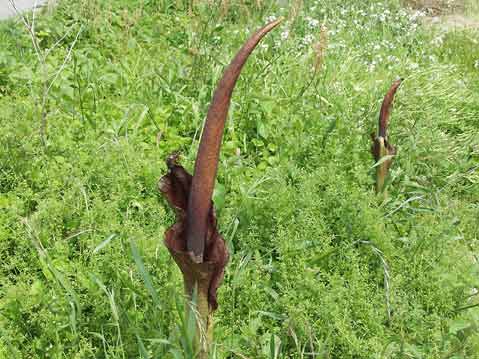Plants that Offend the Nose but Delight the Eyes
Stinky and Beautiful

You may not want to plant these fascinating flowers just outside your door or window, you may not want to plant them at all, but they are sure to garner attention if you do. For one thing, they have unique flower structures that are striking and sculptural. For another, they really do smell bad when in bloom. Both Dracunculus vulgaris, known as voodoo lily or snake lily, and Amorphophallus konjac, devil’s tongue, are pollinated by flies and other insects that are attracted to their smell. These insects normally mate and lay their eggs on rotten meat such as road kill where the eggs hatch with a ready source of food. The similar odor that these flowers produce is just a fake-out.
Both species have the familiar spathe and spadix form that is characteristic for the Araceae or arum family. A funnel-shaped spadix partly encloses the rod-like spathe. Unlike their pristine or colorful relatives such as calla lilies, the color of the flowers also suggests something less than wholesome. Deep reddish purple, to nearly black, they are definitely eye-catching. The spathes are frilled and ruffled on the outer edge and the spadix extends beyond its enclosure. On the spathe, thousands of tiny flowers are borne. In these and many arum species, the flowers are segregated by sex into different zones on the spathe. Female flowers that will produce the seeds are in a ring at the bottom with male flowers above. The flies that visit crawl down the spadix, carrying pollen with them. Because the interior of the flower is very smooth, they may even become trapped inside until the spathe withers and they can make their way out again.
Not only is the architecture and color of these flowers astounding, their size is something to behold as well. The voodoo lily flower is typically about one foot in overall length and is born on a stout stem that can grow to several feet in height. Dragon’s tongues are even more impressive. The flower stalk appears in spring and may stand four to five feet in height. The inflorescence may be another two feet overall. Older and larger corms will produce ever larger flowers.
Voodoo lilies are native to Crete and surrounding areas. These regions have a dry summer, wet winter climate similar to ours here in Southern California. As with many other bulbous species from these climate zones, they are dormant during the dry season. The leaves dry up and disappear entirely, so you may want to put a stake in the ground to remember where the plants are from year to year. You won’t be able to overlook them when their flowers are open, but you might lose them when both leaves and flowers are gone. Dragon’s tongue has a similar cycle, although it hails from Asia. Both do best if the soil is allowed to dry out during their dormancy.
In spite of their stinking flowers, both species have been used as a food source by humans. Their thick bulbs can be processed for their starch. Neither of them should be eaten raw, however, as there are some toxic qualities that must be removed. In Japan, a jellied candy called konnyaku is a popular item made from Amorphophallus konjac starch. Other dishes, including noodles, can be prepared from it and it is considered an aid to dieting because it expands in the stomach. It also moves through the digestive system slowly, providing a feeling of fullness for a longer period.
You may not find either of these species at your local home improvement center, but there are a number of mail order nurseries that carry them. When buying the bulbs, remember that the larger the size, the sooner it will be before you can enjoy the sensational flowers. It can take several years for the plant to come to flowering size. Here are several respected nurseries that carry one or both of them:
- Brent and Becky’s Bulbs, brentandbeckysbulbs.com
- Plant Delights Nursery, plantdelights.com
- Buggycrazy, buggycrazy.vstore.ca



